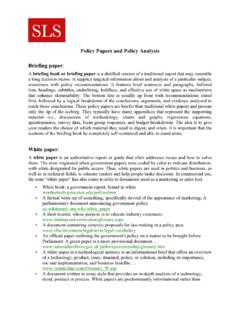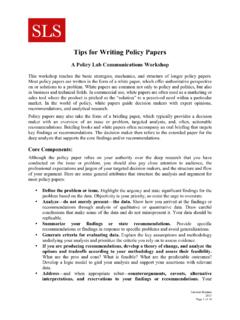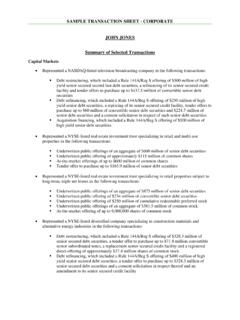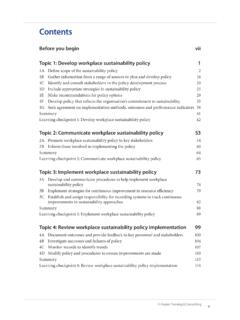Transcription of Policy Memo Guidelines-2 - Stanford Law School
1 Luciana Herman Page 1 of 7 Policy Memos These guidelines teach the strategies, mechanics, and structure of a basic Policy memo , which then serves as the guiding document for an oral briefing of a decision-maker. The workshop offers ways to manage evidence to make Policy recommendations on serious real-world problems. At the end of the workshop, you will be prepared to write short l,000-word memos a skill you will apply repeatedly as Policy writer. Introduction: Know your audience. Keep it short. Though the two genres share many analytical features, a Policy memo is not a research report or white paper. In the real world, memos are developed summaries of varying length. At the Kennedy School , the memo is typically a short distillation of the major findings or recommendations on a key issue or significant problem.
2 Although the memo relies on your authority over the deep research that you have conducted on the issue or problem, it also directly addresses the needs, expectations, and concerns of the decision-maker. Be sure to keep those needs clearly in mind as you conduct your research so that, in about two pages, you are able to: Define the problem or issue. Highlight implications or state significant findings based on the data. Do not merely present data. Show how you arrived at the findings or recommendations through analysis of qualitative or quantitative data. Draw careful conclusions that make sense of the data and do not overstate or misrepresent it. Summarize your findings or state recommendations.
3 Provide specific recommendations or findings in response to specific problems and avoid generalizations. Generate criteria for evaluating options. Explain the key assumptions underlying your analysis and prioritize the criteria you rely on to assess evidence. Analyze each option according to those criteria. What are the pros and cons? What is feasible? What are the predictable outcomes? Support your assertions with relevant data. Address and when appropriate rebut counterarguments, caveats, and reservations to your findings or recommendations. Your credibility as a Policy maker relies on your ability to locate and account for counterargument. You should be especially sensitive to the likely counterarguments your decision-maker faces in implementing or acting on your recommendations or findings.
4 Suggest next steps and/or implementation of the findings or recommendations. Distill the conclusions succinctly in a concluding section and remind the decision-maker of the big picture, the overall goal, the necessity of the investigation, or of the need for specific action. This answers the so what? question that reminds the decision-maker of the value of the research and recommendations. It should be pitched to the decision maker s primary concerns. Adapted from Marie Danziger, Harvard Kennedy School , Option and Decision Memos: Basic Components, 1988. Luciana Herman Page 2 of 7 Locating Recommendations in Competing Data: The PEST and SWOT Feasibility Charts After you have produced findings on the problem, you must orient the data around likely solutions.
5 The PEST and SWOT feasibility charts are essential starting points in locating recommendations from competing data and perspectives. PEST focuses on how political, economic, social, and technological factors affect the feasibility of a recommendation option. Examples of political factors could include applicable regulations, taxation issues and government policies. Economic factors include inflation, business cycles, government spending, and overall cost, and consumer confidence. Social factors include demographics, public attitudes, and income distribution. Technological factors focus on the technology involved in supporting or implementing a recommendation, including energy use and the availability of key technology.
6 PEST analysis involves not only identifying the relevant factors, but also considering options for responding to these influences. There are two primary formats of PEST analysis for Policy makers, which each offer starting points from which you can drill down to increasingly detailed conclusions and recommendations. The first example chart shows the variability in a strong PEST analysis, breaking it into five categories to assess the feasibility of implementing four recommendation options: Political Feasibility, Administrative Feasibility, Equity, Cost Effectiveness, and Environmental Impact. That chart also shows that the Policy writer folded Social Feasibility into the Political Feasibility and Equity tests.
7 The example chart focuses on the problem of pesticides, offering four possible solutions to deal with the problem: (1) Do Nothing/Status Quo, (2) Tax Pesticides, (3) Increase Number of Pesticides Banned, (4) Discourage Pesticides through Tax Breaks to Ecologically Appropriate Crops, (5) Limit the Number of Pesticides that can be applied to a particular crop. The chart then assesses the overall positive and negative outcomes or qualities associated with each possible solution to reveal a dominant recommendation: Tax Pesticides. You can build your own Feasibility Chart by measuring recommendation options in the context of PEST categories and through the perspectives of key interest groups.
8 The more detailed your knowledge of your subject, the more authoritative the outcome of the chart. In this chart, the Policy writer prioritizes five hypothetical solutions to the problem of pesticide use: Options Do Nothing/Status Quo - + - - +/- Tax Pesticides +/- + +/- + + Increase Number of Pesticides Banned +/- - - + - Discourage Pesticides through Tax Breaks to Ecologically Appropriate Crops - - +/- + +/- Limit the Number of Pesticides Used on - +/- - +/- +/- Luciana Herman Page 3 of 7 Certain Crops Criteria Political Feasibility Administrative Feasibility Equity Environmental Impact Economic Impact/Cost Effectiveness The PEST chart shows that, while all five possible recommendations have positive environmental impact, only one of the options predominates among the other criteria.
9 In this Policy researcher s view, taxing pesticides meets the bar of being administratively feasible and equitable to all parties; it has a positive environmental impact and it is both cost effective and offers a positive economic impact. For this Policy writer, taxing pesticides is the best recommendation, which she will highlight early in her memo . You ll note, however, that the first column Political Feasibility shows up as the single negative for her recommendation of Tax Pesticides. Thus, in the body of her memo , the writer needs briefly to address and rebut or qualify the shortcomings of the political feasibility of taxing pesticides. The writer will also discuss the highlights and shortcomings of the other findings, demonstrating, for example, the limitations of increasing the number of banned pesticides and of limiting the amount of pesticides applied to particular crops.
10 A second chart examines the same five possible recommendations through the perspectives of involved interest groups. Stakeholders Chart Options Do Nothing/Status Quo - + + - - - Tax Pesticides + - - + + + Increase Number of Pesticides Banned + - - + - + Discourage Pesticides through Tax Breaks to Ecologically Appropriate Crops + +/- - + + + Limit the Number of Pesticides Used on Certain Crops + - - +/- +/- +/- Interest Groups The Public Traditional Farmers Chemical Production Companies Farm Labor The Environment Organic Farmers The stakeholders chart shows that, while all five possible recommendations (or solutions to the problem of under-regulated and over-used pesticides) have both positive and negative aspects, once again, the solution of taxing pesticides dominates.




